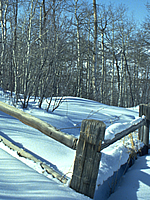
McSherry, G. X.AboutAfter giving some background information on his and his wife's family histories and on his agricultural experience, most of the interview centers on his work as a state legislator, where he chaired the Agriculture Committee and wrote the legislation creating the New Mexico Farm and Ranch Heritage Museum.
Abstract
Tape 1, Side A
[NOTE: See also the interview sessions with Clara Jo McSherry and Ed Remondini.] McSherry explained how his paternal grandparents came separately to the Mimbres Valley, both having had their lives disrupted by the effects of the Emancipation Proclamation. His grandmother came from a plantation in Texas and, after her first husband was killed, worked as a cook at the Harvey House in Deming, N.M. His grandfather, wanting to escape the carpetbaggers in Virginia, came west to Arizona to work as a miner and eventually migrated to Deming. McSherry's mother came from Pennsylvania. She was a schoolteacher who came out to visit her brother and sister, who had moved to a drier climate because the brother had tuberculosis. His parents eventually homesteaded in the area, where they raised cattle and had an apple orchard. McSherry and his wife married in 1945. She, a first-generation American, was born to Italian immigrants. Starting with a hundred-acre farm, the McSherrys have expanded it to over 600 acres. They are very diversified and raise many crops, from cotton to various grains, but about two-thirds of the crops are devoted to livestock feed. The consultant discusses how crops are harvested, whether by hand, their own machines, or by contractors. He also discusses the many changes he's seen in his fifty years of farming, particularly water issues. (They have no surface water, just wells.) He briefly describes the career choices of his seven children and why only one of them is working in agriculture even though they all have a strong love of the land. The consultant once again discusses water issues and the role he feels the Museum will play in making people more aware of where their food and fiber comes from and the importance of water to its production.
Tape 1, Side B
McSherry describes his reasons for being involved in politics and his path to the state legislature. He explains how much time and out-of-pocket expenditures are involved in serving in the state legislature and the satisfaction he derives from it. The discussion then centers on how he was approached, in about 1983, by Dr. Bill Stephens about a museum of agriculture. McSherry was enthusiastic about it and volunteered to try to get funding for it from the state. He said he failed at least twice to get such a bill passed. Many people thought it was connected to New Mexico State University, and he also referred to "personality problems" with the Legislative Finance Committee. The consultant explained in some detail the steps a bill must go through in order to become law. The bill for funding the Museum had to go through two committees: the Agriculture Committee and the Legislative Finance Committee. Often it died in committee. He stated it was not a real popular bill in the legislature because many people felt there were enough museums, and people in the northern part of the state, in particular, were not anxious to fund another one. The consultant described the help Helmuth Naumer provided and the reason the Museum is now under the umbrella of the Office of Cultural Affairs. After the bill was passed there was still the problem of funding. Mr. McSherry describes the help Governor [Bruce] King's son gave, plus the fact that many prominent families across the state provided money to "make this thing go." The consultant provides some insights on how committees function and the role lobbying and compromise play in getting bills passed.
Tape 2, Side A
The discussion on how the bill was passed is continued here. Mr. McSherry specifically mentions the contributions of Senator Johnny Morrow, Senator [Fernando] Macias, Representative Gary King, and Dr. Bill Stephens. In order to garner more votes, the bill was ultimately presented in terms of its economic impact, rather than its educational impact, on the state. Mr. McSherry feels it was fortunate that the appropriations bill for the Museum passed when it did. He gives some background of funding and the various sources of funding, such as capital outlay, the severance tax fund, and bonds, which have to be voted on by the public. He discusses the many obstacles thrown in the path of the bill, including a provision for some private funding for a two-to-one match by the state. He feels this may have actually worked out for the best, as it proved to some people that those behind the bill were determined not to be detoured. He also mentions conflicts over the location of the Museum. It was to be somewhere in Doña Ana County. One of the early ideas had it down by the cotton-ginning lab. Discussion returns to the determination and effort by Dr. Stephens to get the Museum established. As far as the future of the Museum, Mr. McSherry emphasized that this was the work of the two boards. He feels they have good people on them and are doing a good job. He emphasized his belief that the Museum should include all agriculture, including the hydroponic farmers, cattle growers, woolgrowers, ratite (ostriches, etc.) growers, etc.
Tape 2, Side B
Mr. McSherry feels relatively secure that there will always be state funding for the Museum. This is one reason he wanted it under the umbrella of the Office of Cultural Affairs and was totally against the suggestion, in 1995, that it be put under the Department of Agriculture of New Mexico State University. |

